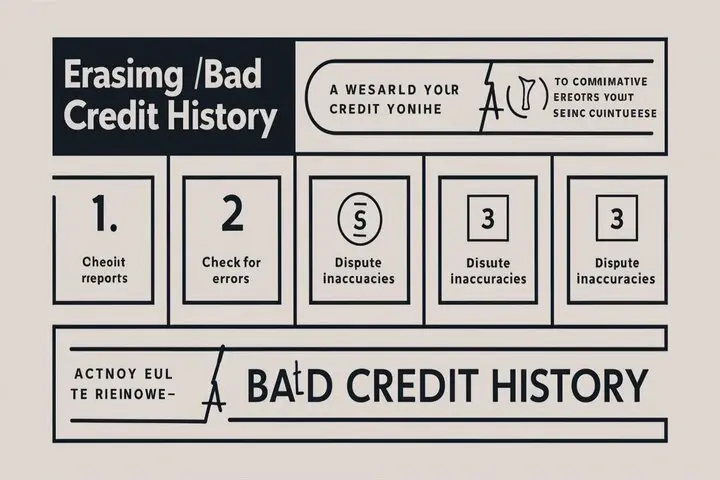-
Posted on: 29 Jul 2024

-
Uncertainty about your credit score can be a significant hurdle. This guide offers a clear, actionable roadmap on how to erase bad credit history, providing practical strategies and expert insights for 2025 to help you rebuild a stronger financial future.
Understanding Your Credit History
Your credit history is a detailed record of how you've managed borrowed money. It's a crucial component of your financial identity, influencing your ability to secure loans, rent apartments, and even obtain certain jobs. Understanding its components is the first step toward improving it.
What Constitutes a Credit Report?
A credit report is a comprehensive document compiled by credit bureaus (in the US, primarily Equifax, Experian, and TransUnion). It details your credit accounts, payment history, credit utilization, length of credit history, and any public records like bankruptcies or liens. This information is used to calculate your credit score.
Key Components of a Credit Report:
- Personal Information: Name, address, Social Security number, date of birth, and employment history.
- Credit Accounts: Details of all credit cards, loans (mortgages, auto loans, student loans), and other lines of credit. This includes the creditor's name, account number, date opened, credit limit or loan amount, current balance, and payment history.
- Payment History: This is the most critical section, showing whether you've paid your bills on time, late, or missed payments. Late payments, even by a few days, can significantly impact your score.
- Credit Utilization: The ratio of your outstanding debt to your total available credit. Keeping this ratio low (ideally below 30%) is vital.
- Length of Credit History: The average age of your credit accounts and the age of your oldest account. A longer history generally indicates more stability.
- Credit Inquiries: Records of when your credit was checked. "Hard inquiries" (when you apply for credit) can slightly lower your score, while "soft inquiries" (like checking your own score) do not.
- Public Records: Information like bankruptcies, foreclosures, liens, and judgments.
What is a Credit Score?
A credit score is a three-digit number that summarizes your creditworthiness. It's a snapshot of your credit history at a particular moment, used by lenders to assess the risk of lending you money. Common scoring models include FICO and VantageScore. As of 2025, credit scores typically range from 300 to 850.
General Credit Score Ranges (2025):
Score Range Rating Implication 800-850 Excellent Best interest rates, highest approval odds. 740-799 Very Good Excellent loan terms, high approval odds. 670-739 Good Generally good loan terms, good approval odds. 580-669 Fair Higher interest rates, may face more scrutiny. 300-579 Poor Difficult to get credit, very high interest rates, may require a co-signer. A "bad credit history" typically refers to a low credit score, often below 600, stemming from negative marks on your credit report such as late payments, high credit utilization, collections, or public records. Erasing bad credit history isn't about magically making negative information disappear; it's about understanding how it got there and implementing strategies to rectify inaccuracies and build positive credit habits.
Legally Removing Errors from Your Credit Report
One of the most direct ways to improve a bad credit history is by identifying and rectifying inaccuracies on your credit report. The Fair Credit Reporting Act (FCRA) grants you the right to dispute any information you believe is inaccurate, incomplete, or unverifiable.
Step 1: Obtain Your Credit Reports
Before you can dispute errors, you need to know what's on your reports. You are entitled to a free credit report from each of the three major credit bureaus (Equifax, Experian, TransUnion) every 12 months through AnnualCreditReport.com. It's advisable to stagger your requests, obtaining one report every four months to monitor for changes and potential new errors throughout the year.
Where to Get Your Free Credit Reports (2025):
- AnnualCreditReport.com: The official, federally mandated source for free credit reports.
- Credit Bureaus Directly: While not free for regular access, you can access your reports directly from Equifax, Experian, and TransUnion if you are disputing information.
- Credit Monitoring Services: Many services offer free or paid access to your credit reports and scores, often with tools to help identify potential errors.
Step 2: Review Your Reports Meticulously
This is where patience and attention to detail are crucial. Go through each section of your reports with a fine-tooth comb. Look for common errors such as:
- Accounts that aren't yours.
- Incorrect personal information (e.g., wrong address, wrong Social Security number).
- Accounts listed as late or delinquent when they were paid on time.
- Incorrect balances or credit limits.
- Duplicate negative entries.
- Outdated negative information that should have been removed.
- Accounts that have been incorrectly marked as closed or reopened.
Step 3: Dispute Inaccuracies with the Credit Bureaus
Once you've identified errors, you must formally dispute them. You can do this online, by mail, or by phone with each credit bureau reporting the inaccuracy.
Disputing by Mail: A Step-by-Step Guide
- Write a Dispute Letter: Clearly state your name, address, and the account you are disputing.
- Identify the Error: Be specific about what information is incorrect and why. For example, "Account ending in 1234 shows a late payment on March 15, 2024, but my records show it was paid on March 10, 2024."
- Provide Supporting Documentation: Include copies (never originals) of any evidence that supports your claim. This could include payment receipts, bank statements, court records, or correspondence with the creditor.
- State Your Desired Resolution: Clearly ask for the inaccurate information to be removed or corrected.
- Send Certified Mail: Send your letter via certified mail with a return receipt requested. This provides proof that the credit bureau received your dispute.
Under the FCRA, credit bureaus have 30 days (or 45 days if you submit the dispute within 30 days of receiving a new credit report) to investigate your claim. They must contact the furnisher of the information (the creditor) to verify its accuracy. If the furnisher cannot verify the information, or if the information is found to be inaccurate, it must be removed or corrected.
Step 4: Dispute Inaccuracies with the Creditor
Sometimes, it's more effective to contact the creditor or debt collector directly first. If you can resolve the issue with them, they will report the correction to the credit bureaus. This can be faster than going through the bureaus, especially for straightforward errors.
When to Contact the Creditor Directly:
- If the error is clearly a mistake by the creditor (e.g., wrong payment date, incorrect balance).
- If you have already paid a debt that is still showing as outstanding.
- If a debt was settled or discharged in bankruptcy but is still reported incorrectly.
Keep detailed records of all communication with creditors, including dates, times, names of representatives, and summaries of conversations. If direct communication doesn't resolve the issue, you can then proceed with disputing with the credit bureaus.
Step 5: Understand the Statute of Limitations for Negative Information
The FCRA limits how long most negative information can remain on your credit report. This is a critical piece of information for understanding "erasing" bad credit history. While you can't erase accurate negative information before its reporting period ends, you can ensure it's removed if it's outdated or incorrect.
Typical Reporting Periods for Negative Information (2025):
Type of Information Time Limit Notes Late Payments 7 years from the date of the delinquency. For severe delinquencies (e.g., 90+ days late), the clock starts when the payment was due. Collections Accounts 7 years from the date of the original delinquency that led to the collection. The date of the original debt is key, not when it was sold to a collector. Charge-Offs 7 years from the date of the original delinquency. Similar to collections, the original delinquency date matters. Bankruptcies Chapter 7: 10 years from the filing date.
Chapter 13: 7 years from the filing date.These are the longest-lasting negative marks. Judgments Varies by state, but often 7-10 years. Some judgments can be renewed. Foreclosures 7 years from the date of the foreclosure. If a negative item has surpassed its reporting period and is still on your report, it is an error and should be disputed immediately. You can find more information on consumer finance resources for further guidance.
Strategies for Improving Your Credit Score
While removing errors is crucial, improving your credit score also requires proactive steps to build positive credit habits. This involves managing your existing debt effectively and demonstrating responsible financial behavior.
1. Pay All Bills On Time, Every Time
Payment history accounts for the largest portion of your credit score (around 35% for FICO). Even a single late payment can have a significant negative impact. Make it a priority to pay at least the minimum amount due on all your credit accounts by the due date.
Tips for On-Time Payments:
- Set Up Automatic Payments: Most lenders allow you to set up automatic payments from your bank account. Ensure you have sufficient funds to cover the payments.
- Use Calendar Reminders: If automatic payments aren't feasible, set up calendar alerts on your phone or computer a few days before the due date.
- Budgeting: Incorporate your debt payments into your monthly budget to ensure you have the funds allocated.
2. Reduce Your Credit Utilization Ratio (CUR)
Credit utilization (around 30% of your score) is the amount of credit you're using compared to your total available credit. High utilization signals to lenders that you may be overextended and at higher risk. Aim to keep your CUR below 30%, and ideally below 10%.
How to Lower Your CUR:
- Pay Down Balances: The most direct way is to pay down the balances on your credit cards. Focus on cards with the highest utilization first.
- Request a Credit Limit Increase: If you have a good payment history with a particular card issuer, you can request a credit limit increase. This will increase your total available credit, lowering your utilization ratio, assuming your spending remains the same. Be aware that some issuers may perform a hard inquiry for this.
- Spread Out Your Spending: If possible, avoid maxing out any single credit card. Distribute your spending across multiple cards, or use a debit card for some purchases.
3. Avoid Opening Too Many New Credit Accounts at Once
Applying for multiple credit accounts in a short period can result in numerous hard inquiries on your credit report, which can lower your score. Each hard inquiry typically impacts your score by a few points for up to a year.
Strategic Credit Applications:
- Only Apply When Necessary: Apply for credit only when you genuinely need it and have a good chance of approval.
- Shop Around for Rates: If you're looking for a loan (e.g., auto loan, mortgage), rate shopping within a short window (typically 14-45 days) is usually treated as a single inquiry by scoring models.
4. Be Patient with Old, Negative Information
As mentioned, negative information has a limited lifespan on your report. While you can dispute errors, you generally cannot remove accurate negative information before it expires. Focus your energy on building positive history to outweigh the negative over time.
Effective Debt Management Approaches
Addressing the root cause of bad credit – often overwhelming debt – is crucial. Several strategies can help you manage and reduce your debt load, which will, in turn, improve your credit utilization and overall financial health.
Debt Snowball vs. Debt Avalanche
These are two popular methods for paying down debt. The best method depends on your personality and financial situation.
Debt Snowball Method:
You pay off your smallest debts first, regardless of interest rate, while making minimum payments on larger debts. Once the smallest debt is paid off, you roll that payment amount into the next smallest debt. This method provides quick wins and psychological motivation.
Debt Avalanche Method:
You pay off your debts with the highest interest rates first, while making minimum payments on others. This method saves you the most money on interest over time.
Feature Debt Snowball Debt Avalanche Focus Smallest balance first Highest interest rate first Psychological Impact High (quick wins) Lower (takes longer to see results) Financial Savings Lower (pays more interest) Higher (pays less interest) Best For Those who need motivation and quick wins. Those who are disciplined and want to save the most money. Debt Consolidation
Debt consolidation involves combining multiple debts into a single, new loan. This can simplify payments and potentially lower your interest rate.
Types of Debt Consolidation:
- Personal Loan: You take out a new personal loan to pay off your existing debts. This can be effective if you qualify for a loan with a lower interest rate than your current debts.
- Balance Transfer Credit Card: Some credit cards offer 0% introductory APR on balance transfers. This can give you a period to pay down debt interest-free, but be mindful of transfer fees and the regular APR after the introductory period.
- Home Equity Loan or HELOC: If you own a home, you might be able to borrow against your home equity. These often have lower interest rates but put your home at risk if you can't repay.
Caution: Debt consolidation doesn't erase debt; it reorganizes it. If you don't address the spending habits that led to the debt, you could end up with the consolidated loan plus new debt.
Debt Management Plans (DMPs)
A Debt Management Plan is offered by non-profit credit counseling agencies. The agency negotiates with your creditors to reduce interest rates, waive fees, and establish a single monthly payment that you make to the agency. They then distribute the payments to your creditors.
Pros of DMPs:
- Can lower interest rates and monthly payments.
- Simplifies payments into one monthly bill.
- Often stops collection calls.
- Can be a stepping stone to rebuilding credit.
Cons of DMPs:
- May require closing credit card accounts.
- Can sometimes be noted on your credit report.
- Typically takes 3-5 years to complete.
When considering a DMP, ensure you are working with a reputable, non-profit credit counseling agency. Look for agencies accredited by organizations like the National Foundation for Credit Counseling (NFCC) or the Financial Counseling Association of America (FCAA).
Negotiating with Creditors
If you're struggling to make payments, don't hesitate to contact your creditors directly. They may be willing to work with you to create a more manageable payment plan, temporarily reduce your interest rate, or offer a settlement for less than the full amount owed.
Tips for Negotiation:
- Be Honest: Explain your financial hardship clearly and concisely.
- Have a Plan: Propose a realistic payment plan you can afford.
- Be Prepared to Compromise: They may not agree to everything you ask for.
- Get Everything in Writing: Any agreement reached should be documented in writing before you make any payments.
Building Positive Credit for the Future
Once you've addressed errors and started managing your debt, the next phase is actively building a positive credit history. This is essential for long-term financial health and for "erasing" the impact of past bad credit.
Secured Credit Cards
A secured credit card requires a cash deposit that typically equals your credit limit. This deposit serves as collateral, making it easier for individuals with bad credit to get approved. By using the card responsibly and making on-time payments, you can demonstrate creditworthiness to lenders and build a positive credit history.
How Secured Cards Work:
- Deposit: You pay a security deposit (e.g., $200-$500).
- Credit Limit: Your credit limit is usually equal to your deposit.
- Usage: Use it for small, planned purchases that you can easily pay off.
- Reporting: Responsible use (on-time payments, low utilization) is reported to the credit bureaus, helping to build your score.
After a period of responsible use (typically 6-12 months), many issuers will review your account and may convert your secured card to an unsecured one, refunding your deposit.
Credit-Builder Loans
A credit-builder loan is a small loan designed specifically to help individuals build or improve credit. The loan amount is held in a savings account by the lender and released to you after you've paid off the loan. Your payments are reported to the credit bureaus.
How Credit-Builder Loans Work:
- You apply for the loan.
- The lender deposits the loan amount into a locked savings account.
- You make regular payments on the loan.
- The lender reports your payment history to the credit bureaus.
- Once the loan is fully repaid, you receive the funds from the savings account.
These loans are excellent for demonstrating consistent payment behavior, a key factor in credit scoring.
Become an Authorized User
If you have a trusted friend or family member with excellent credit, they can add you as an authorized user to one of their credit cards. This means you'll have a card with your name on it, linked to their account. Their positive payment history on that account can then appear on your credit report, potentially boosting your score.
Considerations for Authorized Users:
- Responsibility: The primary cardholder's payment behavior on that account directly impacts your credit. If they miss payments, it will hurt your score.
- Utilization: High utilization on the shared card can also negatively affect your score.
- Creditor Policies: Not all credit card issuers report authorized user activity to credit bureaus, or they may report it differently.
This strategy should be used with extreme caution and only with individuals you trust implicitly.
Rent and Utility Reporting Services
Traditionally, rent and utility payments were not factored into credit scores. However, several services now report these payments to credit bureaus. By signing up for these services (some may have fees), you can get credit for making timely payments on your rent and utilities.
Popular Services (as of 2025):
- Experian Boost (reports utility and telecom payments)
- RentReporters
- LevelCredit
- UltraFICO Score (uses bank account data)
These services can be particularly helpful for individuals who have limited credit history or are trying to recover from past mistakes.
Maintaining Long-Term Credit Health
Rebuilding credit is an ongoing process. Maintaining good credit health requires consistent, responsible financial habits. Here are key strategies for the long term.
Regularly Monitor Your Credit Reports
Don't wait until you need credit to check your reports. Make it a habit to review your credit reports at least annually from each bureau. This helps you catch any new errors, monitor your progress, and stay aware of your credit standing.
Live Within Your Means
The most sustainable way to maintain good credit is to avoid accumulating excessive debt in the first place. Create a realistic budget, track your spending, and prioritize saving. This reduces the temptation to rely on credit for everyday expenses.
Build an Emergency Fund
An emergency fund can prevent you from having to use credit cards for unexpected expenses like medical bills or car repairs. Aim to save 3-6 months of living expenses. This financial cushion provides security and reduces financial stress.
Understand Your Credit Score Factors
Continuously educate yourself on what impacts your credit score. By understanding the weighting of different factors (payment history, utilization, length of history, credit mix, new credit), you can make informed decisions about your financial behavior.
Seek Professional Advice When Needed
If you find yourself overwhelmed by debt or unsure about how to manage your credit, don't hesitate to seek advice from a reputable credit counselor or a financial advisor. They can provide personalized guidance and help you develop a sustainable financial plan.
Conclusion
Erasing bad credit history is not a quick fix but a strategic, multi-faceted process that involves diligence, patience, and consistent good financial behavior. It begins with understanding the components of your credit report and score, then meticulously disputing any inaccuracies to ensure accuracy. Following this, implementing robust debt management strategies and actively building positive credit through tools like secured cards and credit-builder loans are paramount. By consistently paying bills on time, keeping credit utilization low, and avoiding unnecessary new credit applications, you lay the groundwork for a strong financial future. Remember that maintaining good credit is an ongoing commitment, requiring regular monitoring and a disciplined approach to spending and saving. Taking these actionable steps will not only help you recover from past credit challenges but also empower you to achieve your financial goals in 2025 and beyond.










